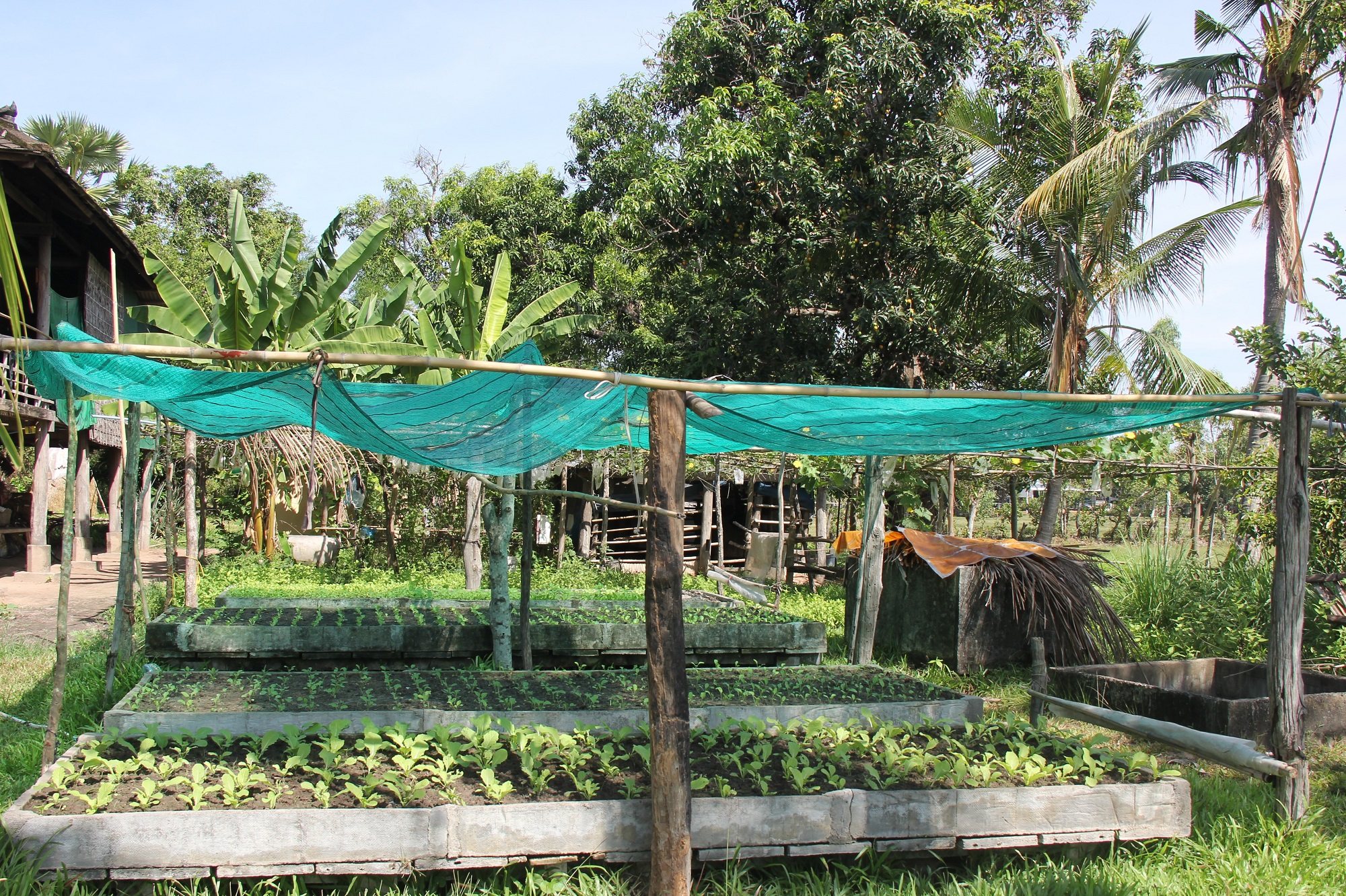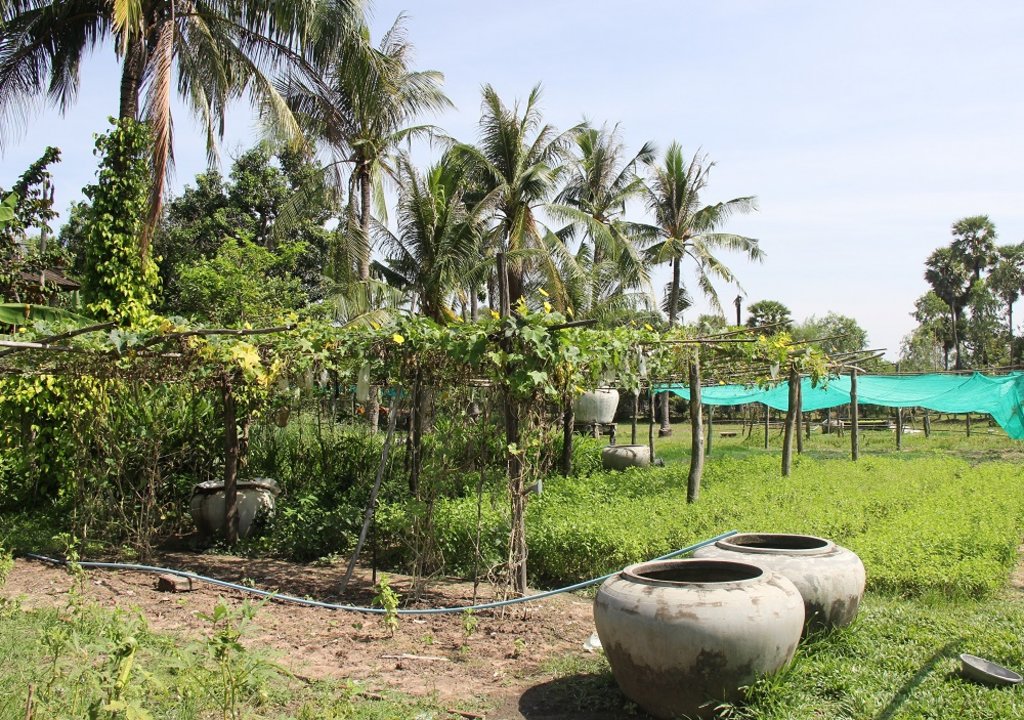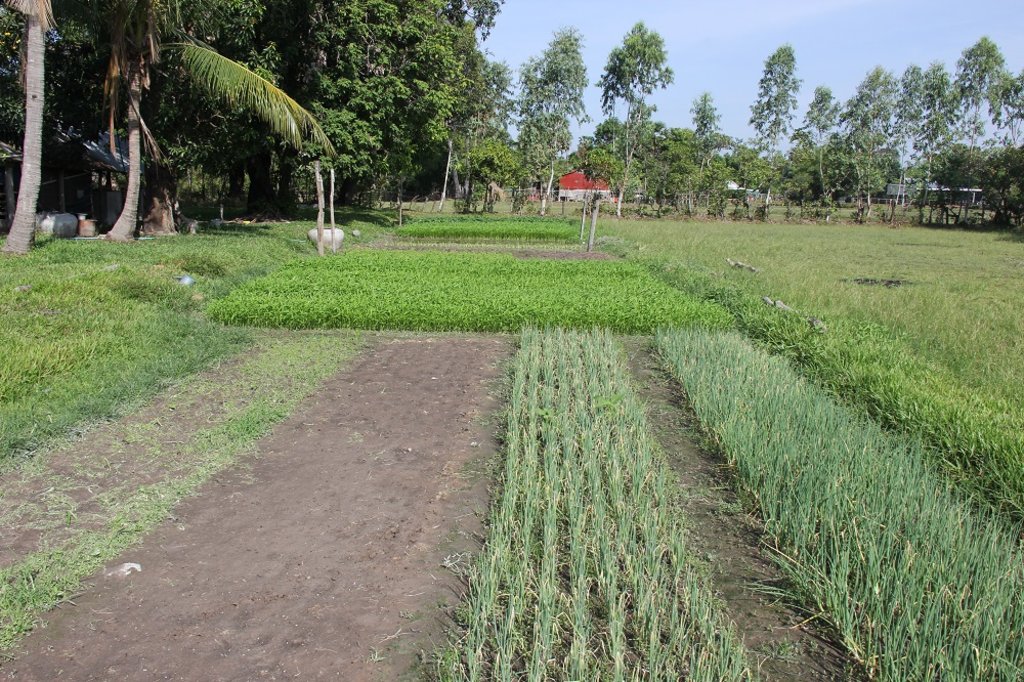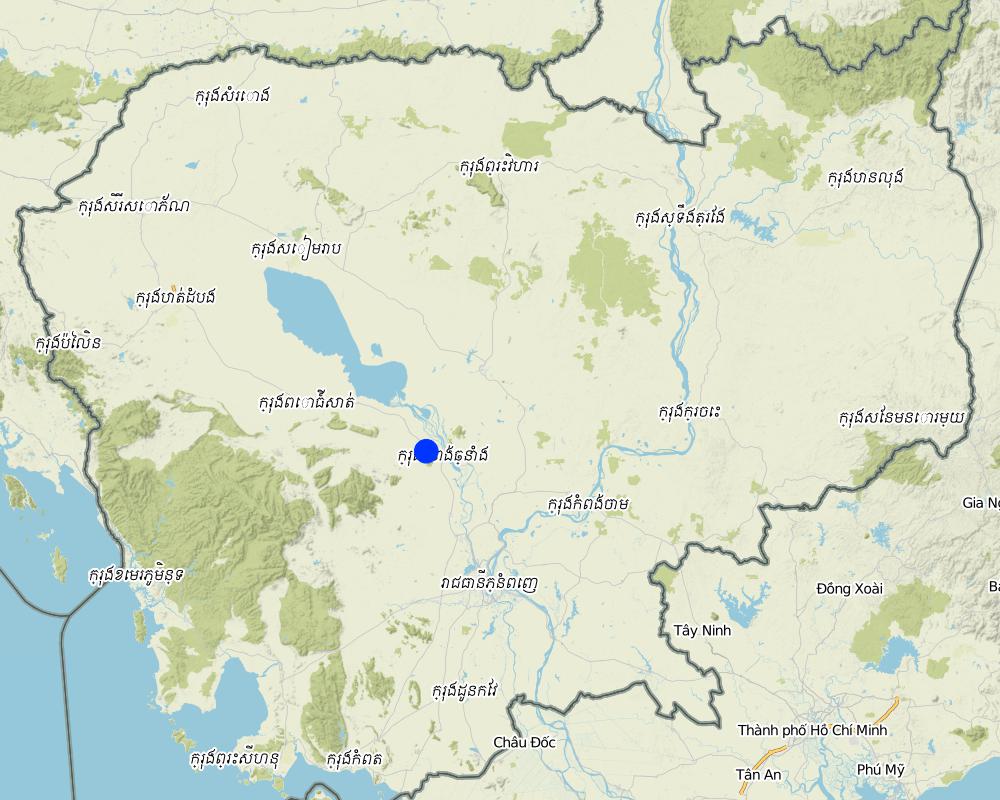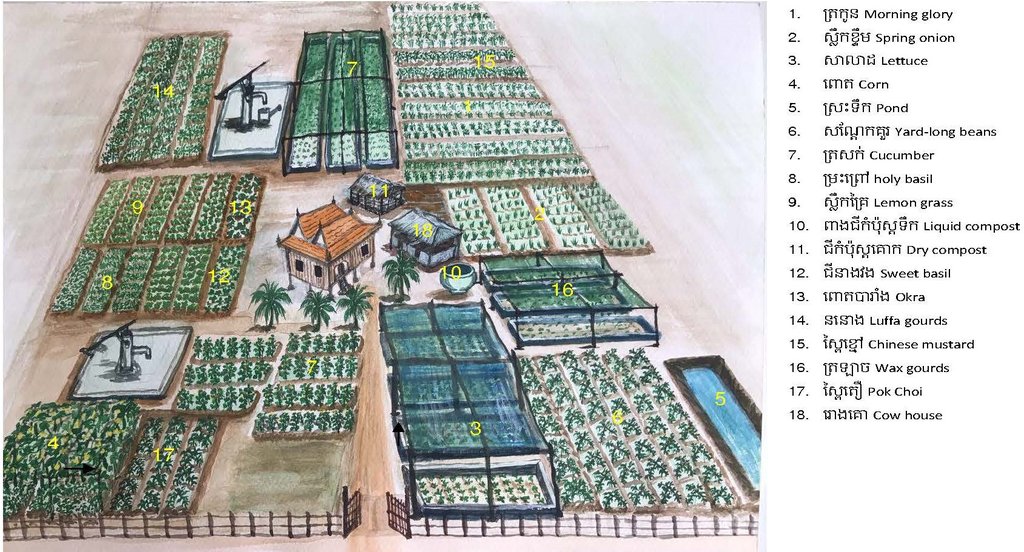Cultivation of organic vegetables to improve the household economy and the soil quality [Cambodia]
- Creation:
- Update:
- Compiler: Sok Pheak
- Editors: Navin Chea, Sophea Tim
- Reviewers: Ursula Gaemperli, Stephanie Jaquet, SO Than, Nicole Harari, Alexandra Gavilano
Organic vegetable farming
technologies_3151 - Cambodia
- Full summary as PDF
- Full summary as PDF for print
- Full summary in the browser
- Full summary (unformatted)
- Cultivation of organic vegetables based on natural principles to improve both the household economy and soil quality: April 19, 2018 (inactive)
- Cultivation of organic vegetables to improve the household economy and the soil quality: April 23, 2018 (inactive)
- Cultivation of organic vegetables to improve the household economy and the soil quality: March 1, 2019 (public)
View sections
Expand all Collapse all1. General information
1.2 Contact details of resource persons and institutions involved in the assessment and documentation of the Technology
Key resource person(s)
land user:
Teav Chat
Farmer
Cambodia
Vice-chief of Agronomic office:
Chhim Bunleang
District Office of Agriculture, Forestry, and Fisheries of Rolea B'ier District
Cambodia
Vice-Chief of Office of Agriculture Extension:
Khem Sambour
Kampong Chhnang Provincial Department of Agriculture, Forestry and Fisheries
Cambodia
Chief of District Office of Agriculture, Forestry and Fisheries of Tuek Phos:
Keo Se
District Office of Agriculture, Forestry and Fisheries of Tuek Phos
Cambodia
Name of project which facilitated the documentation/ evaluation of the Technology (if relevant)
Scaling-up SLM practices by smallholder farmers (IFAD)Name of the institution(s) which facilitated the documentation/ evaluation of the Technology (if relevant)
Royal University of Agriculture (RUA) - Cambodia1.3 Conditions regarding the use of data documented through WOCAT
The compiler and key resource person(s) accept the conditions regarding the use of data documented through WOCAT:
Yes
1.4 Declaration on sustainability of the described Technology
Is the Technology described here problematic with regard to land degradation, so that it cannot be declared a sustainable land management technology?
No
2. Description of the SLM Technology
2.1 Short description of the Technology
Definition of the Technology:
Cultivation of mixed organic vegetables utilizing natural fertilizers and homemade pesticides so as to reduce expenditure on external agriculture inputs, as well as produce organic vegetables that safeguard both the producers’ and consumers’ health. This practice is mainly suitable for the maintenance and improvement of the soil’s fertility.
2.2 Detailed description of the Technology
Description:
Cultivation of mixed organic vegetables or agriculture based on natural principles is a system which utilizes raw materials, including green plants, animal manure, farm wastes as well as medical plants. All of these materials can be found locally. It avoids the use of any chemical substances or insecticides for the elimination of insects. The implementation of this technology ensures the health of humans, animals, and organisms living in the soil, thereby also securing the soil’s fertility. Moreover, it helps to improve the household economy by reducing the costs of buying chemical fertilizers and other materials (MAFF, 2012, MoEYS & VVOB Cambodia, 2013, Social Compass, 2017).
Ms. Teav Chat is one of the farmers growing organic vegetables who was selected to be interviewed for this case study. She has won the national award of best farmer in the production of organic vegetables. She lives in Thma Reab village, Pongro commune, Rolea B'ier district, Kompong Chhnang province, Cambodia. The production of mixed organic vegetables has been implemented since 2004, under the initiative of the Cambodia Center for Study and Development in Agriculture (CEDAC). Around her house she currently grows vegetables on 0.70 ha of land. During the study, she was cultivating mixed organic vegetables including lettuce, cucumbers, yard-long beans, Chinese mustard, pok choi, choy sum, morning glory, spring onions, luffa gourds, wax gourds, holy basil, sweet basil, lemon grassand okra. The most important vegetables out of this group are lettuce, cucumbers, yard-long beans, cabbage vegetables, morning glory and spring onions.
The fundamental components of this technology are the production, and utilization of natural fertilizers (cow manure, dry compost and liquid compost), the combination of medical plants containing natural poisons to combat pests, a natural irrigation source (such as digging a well or a pond), multi cropping, intercropping, as well as crop rotation. As she raises cows, only cow manure is used as fertilizer. Dry compost is made from fresh manure, the leaves of woody herbs or other green leafed plants, rice straw and biochar. Then, the liquid compost is mixed with cow manure, woody herbs, fish heads, boraphed, and cow’s urine. Remarkably, the farmer places these ingredients mixed together with cow’s urine that is collected daily without addition of water. Regarding the production of insecticide, she created a mixture of chili, galangal, together with the leaves or shells of the downy thorn apple.
The main purpose of this technology is to obtain mixed organic vegetables and generate a more regular household income by also reducing the expenses involved in buying chemical fertilizers and pesticides. In other words, organic vegetables have a solid domestic market, consisting of home-based buyers, and so the farmer spends less time for selling her production. The crop diversification respectively mixed organic vegetables supports the farmer also in reducing the exposure to market fluctuations. This means that she should have a wide range of organic vegetables in order to supply the market during all seasons, thereby being able to generate an income throughout the year. In this way the farmer earns a net income 3,330,000 Riel per year. Beside this, the cultivation of organic vegetables using natural fertilizers improves the soil’s fertility. In this way the soil gets rich in microorganisms such as earth worms and other micro-organisms (bacteria or fungi) which play a vital role in decaying organic matter which transform into nutrients for the plants.
In this case study, the natural fertilizer cow manure was used whilst drying the soil in the field or when ploughing the soil in order to expose it. The dry compost is generally applied at the base of the crop roots when the vegetable are planted. Furthermore the liquid compost is used as a fertilizer once the crop begins to grow by irrigating it every three days in the evenings. About 100 ml of liquid compost is mixed with 10 liters of water in order to irrigate the rows with a width of 0.5 meters and a length of 10 meters. For regular maintenance, the fertilizer is added to each of the vegetable crops depending also on the quantity of natural fertilizer that is available. Natural pesticides are also used to ward off insects or to prevent them from destroying the crop.
2.3 Photos of the Technology
2.5 Country/ region/ locations where the Technology has been applied and which are covered by this assessment
Country:
Cambodia
Region/ State/ Province:
Thma Reab village, Pongro Commune, Rolea B'ier District, Kampong Chhnang Province.
Further specification of location:
Rural area
Specify the spread of the Technology:
- evenly spread over an area
If precise area is not known, indicate approximate area covered:
- < 0.1 km2 (10 ha)
Comments:
This technology is implemented on the land area 0.70 hectare.
Map
×2.6 Date of implementation
Indicate year of implementation:
2004
2.7 Introduction of the Technology
Specify how the Technology was introduced:
- through projects/ external interventions
Comments (type of project, etc.):
Under the initiative of the Cambodia Center for Study and Development in Agriculture (CEDAC).
3. Classification of the SLM Technology
3.1 Main purpose(s) of the Technology
- improve production
- preserve/ improve biodiversity
- create beneficial economic impact
- create beneficial social impact
3.2 Current land use type(s) where the Technology is applied

Cropland
- Annual cropping
Annual cropping - Specify crops:
- legumes and pulses - beans
- vegetables - leafy vegetables (salads, cabbage, spinach, other)
Number of growing seasons per year:
- 3
Comments:
The farmer cultivated main crops, such as lettuce, cabbage, morning glories and yard-long beans.
3.4 Water supply
Water supply for the land on which the Technology is applied:
- mixed rainfed-irrigated
3.5 SLM group to which the Technology belongs
- integrated soil fertility management
- integrated pest and disease management (incl. organic agriculture)
- home gardens
3.6 SLM measures comprising the Technology

agronomic measures
- A2: Organic matter/ soil fertility
- A7: Others
Comments:
The farmer used natural fertilizers such as cow manure, dry compost, and liquid compost to preserve the soil fertility for the vegetable growing. She also uses botanical pesticide to prevent crops from harm by insects.
3.7 Main types of land degradation addressed by the Technology

biological degradation
- Bl: loss of soil life
- Bp: increase of pests/ diseases, loss of predators
3.8 Prevention, reduction, or restoration of land degradation
Specify the goal of the Technology with regard to land degradation:
- prevent land degradation
- reduce land degradation
4. Technical specifications, implementation activities, inputs, and costs
4.1 Technical drawing of the Technology
Technical specifications (related to technical drawing):
The technology is being applied on 0.70 hectares of land. The wide range of organic vegetables include lettuce, cucumbers, yard-long beans, Chinese mustard, pok choi, choy sum, morning glory, spring onions, luffa gourds, wax gourds, holy basil, sweet basil, lemon grass, okra, Edible Amaranth and Green Amaranth. This cultivation practice applies natural fertilizers, including cow manure, dry compost, liquid compost, and insecticide made of medicinal plants containing natural poisons. For irrigation purposes there is a pond which measures 10 meters in length, 6 meters in width and 4 meters in depth and also a well with a depth of 10 meters. The cow shed is 24 square meters, housing a herd of 6 cattle.
Author:
Mr. Khuon Sophal
Date:
23/05/2017
4.2 General information regarding the calculation of inputs and costs
Specify how costs and inputs were calculated:
- per Technology area
Indicate size and area unit:
0.70 ha
other/ national currency (specify):
Riel
If relevant, indicate exchange rate from USD to local currency (e.g. 1 USD = 79.9 Brazilian Real): 1 USD =:
4000.0
Indicate average wage cost of hired labour per day:
20000 Riel
4.3 Establishment activities
| Activity | Timing (season) | |
|---|---|---|
| 1. | Bring the soil on the implementation area | During the dry season |
| 2. | Soil preparation | During the dry season |
| 3. | Make shelter for planting the seedlings | 1 day |
| 4. | Building house for dry compost | 1 day |
| 5. | Buying the jar for making the liquid compost | 1 day |
Comments:
The farmer starts growing vegetable in June of the year.
4.4 Costs and inputs needed for establishment
| Specify input | Unit | Quantity | Costs per Unit | Total costs per input | % of costs borne by land users | |
|---|---|---|---|---|---|---|
| Labour | Bring the soil on the implementation area | person-day | 3.0 | 20000.0 | 60000.0 | 100.0 |
| Labour | Soil preparation | person-day | 6.0 | 20000.0 | 120000.0 | 100.0 |
| Labour | Make shelter for planting crop | person-day | 1.0 | 20000.0 | 20000.0 | 100.0 |
| Labour | Building house for dry compost | person-day | 1.0 | 20000.0 | 20000.0 | 100.0 |
| Equipment | Watering cans | pair | 4.0 | 25000.0 | 100000.0 | 100.0 |
| Equipment | Spade | piece | 1.0 | 20000.0 | 20000.0 | 100.0 |
| Equipment | Hoe | piece | 2.0 | 25000.0 | 50000.0 | 100.0 |
| Equipment | Pumping machine | set | 1.0 | 800000.0 | 800000.0 | 100.0 |
| Plant material | Chinese mustard | package | 1.0 | 2000.0 | 2000.0 | 100.0 |
| Plant material | Morning glory | can | 1.0 | 2000.0 | 2000.0 | 100.0 |
| Plant material | Lettuce | package | 1.0 | 4000.0 | 4000.0 | 100.0 |
| Plant material | Pok choi | package | 1.0 | 2000.0 | 2000.0 | 100.0 |
| Plant material | Choy sum | package | 1.0 | 8000.0 | 8000.0 | 100.0 |
| Plant material | Cucumber | can | 1.0 | 5000.0 | 5000.0 | 100.0 |
| Plant material | Yard-long beans | can | 1.0 | 2000.0 | 2000.0 | 100.0 |
| Plant material | Luffa gourds | can | 1.0 | 2000.0 | 2000.0 | 100.0 |
| Construction material | Net | piece | 3.5 | 28000.0 | 98000.0 | 100.0 |
| Construction material | Bamboo | stem | 50.0 | 5000.0 | 250000.0 | 100.0 |
| Other | Holy basil | package | 1.0 | 2500.0 | 2500.0 | 100.0 |
| Other | Okra | package | 2.0 | 2500.0 | 5000.0 | 100.0 |
| Other | Sweet basil | package | 1.0 | 2500.0 | 2500.0 | 100.0 |
| Other | Corn | kg | 1.0 | 4500.0 | 4500.0 | 100.0 |
| Total costs for establishment of the Technology | 1579500.0 | |||||
| Total costs for establishment of the Technology in USD | 394.88 | |||||
4.5 Maintenance/ recurrent activities
| Activity | Timing/ frequency | |
|---|---|---|
| 1. | Soil preparation for vegetable cultivation | 6 days |
| 2. | Seedling transplantation | 3 days |
| 3. | Watering (self-implemented) | everyday |
| 4. | Apply the liquid compost | Once per 3 days |
| 5. | Weeding | every day |
4.6 Costs and inputs needed for maintenance/ recurrent activities (per year)
| Specify input | Unit | Quantity | Costs per Unit | Total costs per input | % of costs borne by land users | |
|---|---|---|---|---|---|---|
| Labour | Soil preparation for vegetables cultivation | person-day | 6.0 | 20000.0 | 120000.0 | 100.0 |
| Labour | Seedling transplantation | person-day | 3.0 | 20000.0 | 60000.0 | 100.0 |
| Labour | Weeding | person-day | 15.0 | 20000.0 | 300000.0 | 100.0 |
| Labour | Irrigating the liquid compost | person-day | 3.0 | 20000.0 | 60000.0 | |
| Equipment | Repair equipment to repair the water pumping machine | set | 1.0 | 260000.0 | 260000.0 | 100.0 |
| Fertilizers and biocides | Biochar | bag | 10.0 | 1000.0 | 10000.0 | 100.0 |
| Fertilizers and biocides | Cow manure | kg | 10.0 | 250.0 | 2500.0 | 100.0 |
| Fertilizers and biocides | Woody herbs | kg | 10.0 | 600.0 | 6000.0 | 100.0 |
| Total costs for maintenance of the Technology | 818500.0 | |||||
| Total costs for maintenance of the Technology in USD | 204.63 | |||||
Comments:
For the woody herb, she usually doesn't buy, because she can be found in the village.
4.7 Most important factors affecting the costs
Describe the most determinate factors affecting the costs:
The farmer has to change the bamboo construction as it lasts only for 2 years.
5. Natural and human environment
5.1 Climate
Annual rainfall
- < 250 mm
- 251-500 mm
- 501-750 mm
- 751-1,000 mm
- 1,001-1,500 mm
- 1,501-2,000 mm
- 2,001-3,000 mm
- 3,001-4,000 mm
- > 4,000 mm
Specifications/ comments on rainfall:
In 2015, the annual rainfall was 1209 mm
In 2014, the annual rainfall was 1420.74 mm
In 2013, the annual rainfall was 1367.5 mm
Indicate the name of the reference meteorological station considered:
Ministry of Water Resources and Meteorology (2015)
Agro-climatic zone
- sub-humid
5.2 Topography
Slopes on average:
- flat (0-2%)
- gentle (3-5%)
- moderate (6-10%)
- rolling (11-15%)
- hilly (16-30%)
- steep (31-60%)
- very steep (>60%)
Landforms:
- plateau/plains
- ridges
- mountain slopes
- hill slopes
- footslopes
- valley floors
Altitudinal zone:
- 0-100 m a.s.l.
- 101-500 m a.s.l.
- 501-1,000 m a.s.l.
- 1,001-1,500 m a.s.l.
- 1,501-2,000 m a.s.l.
- 2,001-2,500 m a.s.l.
- 2,501-3,000 m a.s.l.
- 3,001-4,000 m a.s.l.
- > 4,000 m a.s.l.
Indicate if the Technology is specifically applied in:
- not relevant
5.3 Soils
Soil depth on average:
- very shallow (0-20 cm)
- shallow (21-50 cm)
- moderately deep (51-80 cm)
- deep (81-120 cm)
- very deep (> 120 cm)
Soil texture (topsoil):
- medium (loamy, silty)
Soil texture (> 20 cm below surface):
- medium (loamy, silty)
Topsoil organic matter:
- high (>3%)
If available, attach full soil description or specify the available information, e.g. soil type, soil PH/ acidity, Cation Exchange Capacity, nitrogen, salinity etc.
The soil texture of the land area for implementing this technology is medium (loamy, silty) and Pratash Lang soil, which has pH 6.5.
5.4 Water availability and quality
Ground water table:
< 5 m
Availability of surface water:
good
Water quality (untreated):
good drinking water
Is water salinity a problem?
No
Is flooding of the area occurring?
No
5.5 Biodiversity
Species diversity:
- low
Habitat diversity:
- low
5.6 Characteristics of land users applying the Technology
Sedentary or nomadic:
- Sedentary
Market orientation of production system:
- mixed (subsistence/ commercial)
Off-farm income:
- less than 10% of all income
Relative level of wealth:
- average
Individuals or groups:
- individual/ household
Level of mechanization:
- mechanized/ motorized
Gender:
- women
Age of land users:
- elderly
5.7 Average area of land used by land users applying the Technology
- < 0.5 ha
- 0.5-1 ha
- 1-2 ha
- 2-5 ha
- 5-15 ha
- 15-50 ha
- 50-100 ha
- 100-500 ha
- 500-1,000 ha
- 1,000-10,000 ha
- > 10,000 ha
Is this considered small-, medium- or large-scale (referring to local context)?
- medium-scale
Comments:
The farmer has 0.50 ha of homeland and 0.30 ha of paddy fields. Also, it has already the land title.
5.8 Land ownership, land use rights, and water use rights
Land ownership:
- communal/ village
Land use rights:
- individual
Water use rights:
- individual
5.9 Access to services and infrastructure
health:
- poor
- moderate
- good
education:
- poor
- moderate
- good
technical assistance:
- poor
- moderate
- good
employment (e.g. off-farm):
- poor
- moderate
- good
markets:
- poor
- moderate
- good
energy:
- poor
- moderate
- good
roads and transport:
- poor
- moderate
- good
drinking water and sanitation:
- poor
- moderate
- good
financial services:
- poor
- moderate
- good
6. Impacts and concluding statements
6.1 On-site impacts the Technology has shown
Socio-economic impacts
Production
crop production
Quantity before SLM:
20%
Quantity after SLM:
50%
crop quality
Comments/ specify:
The farmer uses natural fertilizer such as compost (liquid and dry) that soil rich nutrient to make crop growing well and she uses botanical pesticide to prevent insect for getting good crop quality.
risk of production failure
Comments/ specify:
The farmer has a very professional knowledge on organic vegetable growing through the participaton of the training by CEDAC and through her broad own expericence since 2004. This helped to reduce the risk of production failure to a minimum.
product diversity
Comments/ specify:
She has cultivated a broad variety of organic vegetables so as she increased the production for the household consumption and for the market demand.
land management
Comments/ specify:
The farmer uses natural fertilizer to improve soil quality and the different crop are absorb different nutrition from soil. On the other hand, crop help to reduce soil erosion.
Income and costs
expenses on agricultural inputs
Comments/ specify:
The farmer did not spend much money to external agricultural inputs due to getting the raw material for organic vegetable farming in her surroundings.
farm income
Comments/ specify:
First of all she increased the production and accordingly she was also able to increase her income. Then also she was able to reduce the exposure to market price fluctuations because she is connected to a solid domestic market, consisting of home-based buyers. By this she spend not only less time for selling her products also she is getting always very solid or even higher prices for these species of organic vegetables.
workload
Comments/ specify:
In her family need to spend more time for work in farming like the maintenance activities on crops, making compost (dry and liquid) and botanical pesticide.
Socio-cultural impacts
food security/ self-sufficiency
Comments/ specify:
The farmer has actually more than enough organic vegetables to meet her own demand during the whole year.
SLM/ land degradation knowledge
Comments/ specify:
Farmer was a participant who join with CEDAC training on organic vegetables and base on her experience long time with growing organic vegetable, making composting and botanic pesticide.
Ecological impacts
Soil
soil compaction
Comments/ specify:
The crops keep the soil moisture and the compost making the soil rich nutrient and microorganism like earth worm which promote the soil aeration.
nutrient cycling/ recharge
Comments/ specify:
Difference crop can absorb different nutrient and the crop residuals are a supplement fertilizer for the soil.
soil organic matter/ below ground C
Comments/ specify:
Using compost and cow manure improved the soil fertility and enriched the soil by microorganism so that crop grows well.
Biodiversity: vegetation, animals
beneficial species
Comments/ specify:
This technology promoted many different microorganisms such as for example bacteria and fungi.
pest/ disease control
Comments/ specify:
The farmer uses botanical pesticide to prevent harmful insects. And the grow of different crops can reduce disease and insects as well.
6.2 Off-site impacts the Technology has shown
Farmer can produce organic vegetable to provide the consumers with healthy food.
Comments/ specify:
Because of farmer do not use chemical pesticide and do not use chemical fertilizer for growing crop.
6.3 Exposure and sensitivity of the Technology to gradual climate change and climate-related extremes/ disasters (as perceived by land users)
Gradual climate change
Gradual climate change
| Season | increase or decrease | How does the Technology cope with it? | |
|---|---|---|---|
| annual temperature | increase | well | |
| annual rainfall | increase | well |
Other climate-related consequences
Other climate-related consequences
| How does the Technology cope with it? | |
|---|---|
| extended growing period | well |
Comments:
The dry season is extended, so the growing period of vegetables is extended accordingly.
6.4 Cost-benefit analysis
How do the benefits compare with the establishment costs (from land users’ perspective)?
Short-term returns:
very positive
Long-term returns:
slightly positive
How do the benefits compare with the maintenance/ recurrent costs (from land users' perspective)?
Short-term returns:
positive
Long-term returns:
positive
6.5 Adoption of the Technology
- 1-10%
If available, quantify (no. of households and/ or area covered):
10 households
Of all those who have adopted the Technology, how many did so spontaneously, i.e. without receiving any material incentives/ payments?
- 91-100%
Comments:
10 households adopted the technology without receiving any materials incentive/payments, they paid by themselves.
6.6 Adaptation
Has the Technology been modified recently to adapt to changing conditions?
No
6.7 Strengths/ advantages/ opportunities of the Technology
| Strengths/ advantages/ opportunities in the land user’s view |
|---|
| The farmer is able to grow vegetables based on market demand, and mixed organic vegetables are easy to sell, and so it is possible to generate a higher income throughout the whole year. |
| The soil is fertile because of the use of natural fertilizer compared with the previous use of chemical fertilizer which caused crusting. |
| It is an adaptation to climate change, so that water resources are available for crop irrigation in times of drought. |
| Strengths/ advantages/ opportunities in the compiler’s or other key resource person’s view |
|---|
| The farmer obtains organic vegetables for daily household consumption and generates an income. |
| Improve and maintain the soil’s productivity through the use of natural fertilizers. |
| Reduce expenditure on external agricultural inputs such as chemical fertilizers and pesticides. |
6.8 Weaknesses/ disadvantages/ risks of the Technology and ways of overcoming them
| Weaknesses/ disadvantages/ risks in the land user’s view | How can they be overcome? |
|---|---|
| Lack of dry compost and liquid compost for vegetables. | Increasing the manufacture of both dry and liquid compost. |
| Presence of numerous insects. | Manufacture insecticide from medicinal plants containing natural poisons. |
| Weaknesses/ disadvantages/ risks in the compiler’s or other key resource person’s view | How can they be overcome? |
|---|---|
| The farmer met difficulties of implementing the technology in cultivating mixed organic vegetables. | Under the initiative of the Cambodia Center for Study and Development in Agriculture (CEDAC). |
| A lack of labor to grow and maintain organic vegetables. | Use of drip irrigation to save time and labor. |
7. References and links
7.1 Methods/ sources of information
- field visits, field surveys
1 place
- interviews with land users
2 persons
- interviews with SLM specialists/ experts
4 persons
When were the data compiled (in the field)?
23/05/2017
7.3 Links to relevant online information
Title/ description:
MAFF. (2006). Technology stardardize: Home gardening. In Khmer. (Ministry of Agriculture, Forestry and Finsheries(MAFF). Phnom Penh.
URL:
Retrieved from https://drive.google.com/file/d/0B3kkBprEzhDoMWtPeXZUNE4teTQ/preview
Title/ description:
MAFF. (2012). Principle introduction for extension workers on organic vegetable production. (1st Edition). Phnom Penh: Ministry of Agriculture, Forestry and Finsheries(MAFF). In Khmer.
URL:
Retrieved from http://www.maff.gov.kh/agri-tech/40-ការដាំដុះដំណាំ/ដំណាំបន្លែ/1635-ផលិតកម្មដំណាំបន្លែសរីរាង្គ.html
Title/ description:
MoEYS & VVOB Cambodia. (2013). Teaching Methodology for Agricultural Life Skills Education for Teacher Training Centers:Part 3 Organic gardening (1st edition). Phnom Penh: Ministry of Education, Youth and Sport.
URL:
Retrieved from http://www.vvob.be/cambodia/sites/default/files/content_manual_part_3_organic_gardening.pdf
Title/ description:
Social Compass. (2017). An Organic Story (Khmer w/Eng subtitle).
URL:
Retrieved February 5, 2017, from https://www.youtube.com/watch?v=rZMsgQxcEWM&feature=youtu.be
Links and modules
Expand all Collapse allLinks
No links
Modules
No modules


